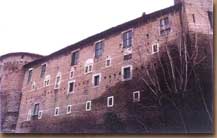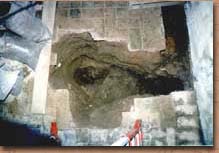Damp in the cloister of the church of Ss. Quattro Coronati
edited by Leo LombardiFirst of all we have to investigate the location of the damp patches and the origin of them. Four can be the causes: rain, underground water with capillarity, leak of some tube or drain, underground reservoirs. The results on the walls are the same, therefore we can measure the moisture with an instrument and delimit the patches. The form and the location of them can give us an idea of the origin. For the rain we have to control all the system of roof drains. We know that exists an underground reservoir, we have to look for it and to see if there is water in; investigate about his condition and if there are leaks or fractures; from where it receives water. Than we must realise little excavations in the walls and floor. If the moisture is consequence of capillarity rise the problem is to understand why there is so much water in the underground. Many times the origin of water is some tube or some drain so that we'll look for them. It is a chain, because if we find a tube or a drain (in the area there are many roman drains) we have to look from where the water comes. At the end of this survey we can decide how intervene and which of the classic systems we can utilize.
|
|
|
Fig. 1 - The outside of the church complex, on via dei Querceti with the triangular-shaped damp stain.
Fig. 2 - The late medieval drain of the cloister. |
|
|
|
|

